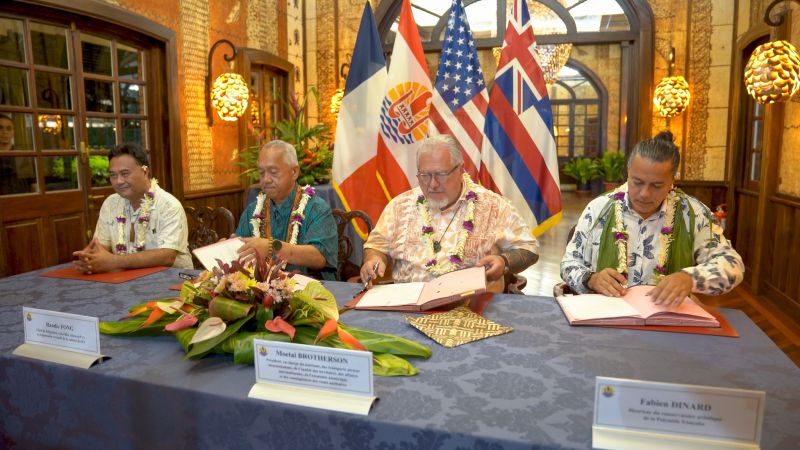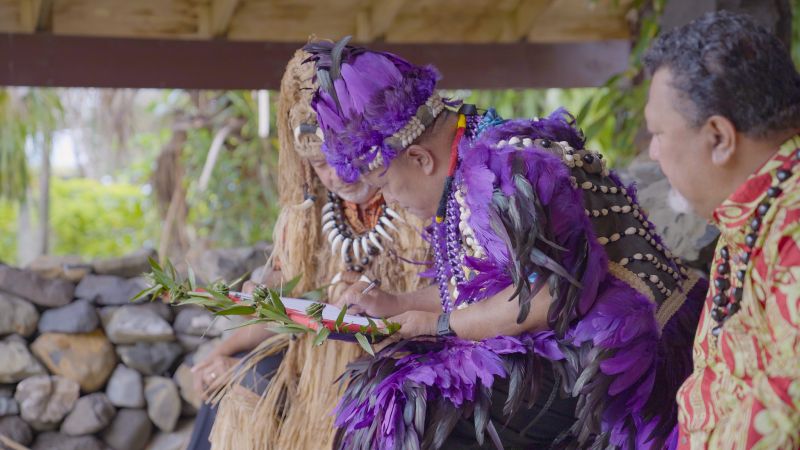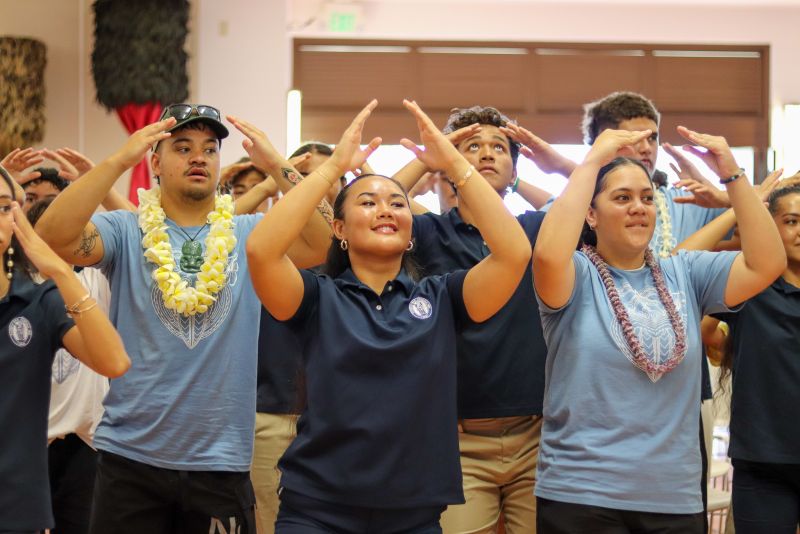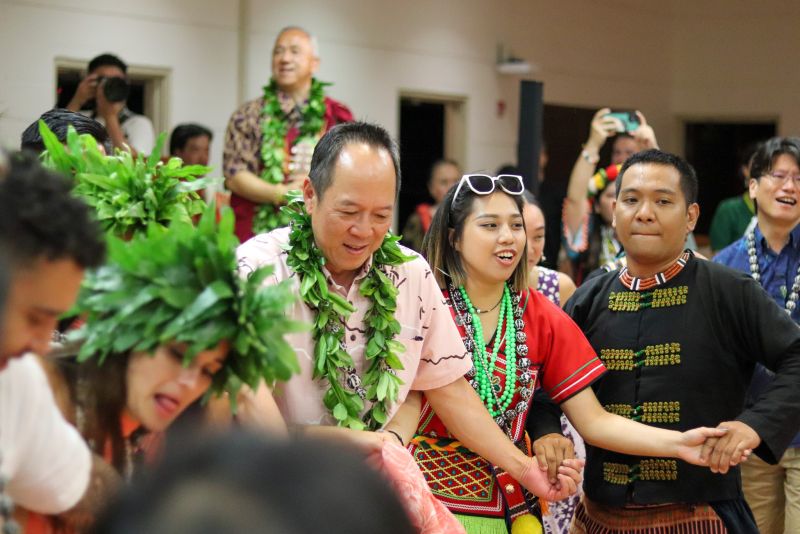Digital Collections
Celebrating the breadth and depth of Hawaiian knowledge. Amplifying Pacific voices of resiliency and hope. Recording the wisdom of past and present to help shape our future.
Kaʻiwakīloumoku Pacific Indigenous Institute
Kauwela 2025
Since its inception in 2018, Kamehameha Schools’ ʻAha Moananuiākea Pacific Consortium, through the work of the Kaʻiwakīloumoku Pacific Indigenous Institute, has established relationships with Indigenous organizations and learning communities throughout the Pacific. With 15 cultural-educational partnerships representing 10 nations speaking four world languages and eight Indigenous languages across six time zones, our ancestral oceanic homeland, Moananuiākea, serves as a global educational canvas for the highest levels of learning to empower and unite Indigenous peoples; revitalize native language, culture, and identity; and restore, sustain and steward our diverse environments and ecosystems through partnerships and collaborations.
At the heart of these partnerships is pilina: relationships, kinship. Tahiti and its neighboring archipelagos are the home of our kūpuna; it is our place of origin. For Kānaka ʻŌiwi, the native people of Hawaiʻi, there is a longing to connect to these ancestral places and be reunited with our ʻohana — those with whom we share the same genealogy and Pacific heritage. When our haumāna engage with other Polynesian youth, their sense of identity and belonging deepens and they begin to see their place as Hawaiians in a much larger Pacific world. These Moananuiākea connections can be seen as a much older and deeper exploration of our ancestral E Ola! roots, as well as an assertive act of self-determination as we broaden our sense of identity and understanding of ourselves as Hawaiians and Polynesians within this vast and dynamic Pacific universe we call home.
Our Tahitian ʻohana feel the same way about their interactions with Hawaiʻi and Hawaiians. This is what moved the three mayors of the island of Raʻiātea — Thomas Moutame of Taputapuātea, Cyril Tetuanui of Tumaraʻa, and Matahi Brotherson of Uturoa — to invite Kamehameha Schools to sign a formal declaration titled “Cultural Heritage, Education, and Community Exchange Agreement between Kamehameha Schools and the Municipalities of Raiatea.” This document was formalized in a traditional ceremony and ratified through the drinking of ʻawa at Kaʻiwakīloumoku in January 2025. It encourages mutual engagement between our youth, elders, educators, innovators, athletes, professionals and cultural practitioners over the next 5 years.
This was a precursor to a much broader agreement that brought together cultural and elected leaders representing the three apices of the Polynesian Triangle: Hawaiʻi, Rapa Nui, and Aotearoa; with Tahiti, specifically Raʻiātea, at the heart of this historic alliance. Committing to collaborative efforts that enrich and unify Polynesia, Kamehameha Schools and the Office of Hawaiian Affairs signed this agreement in a very elaborate and profoundly moving ceremony at Marae Taputapuātea during the Heiva i Raromatai, a renowned Tahitian performing arts festival which drew thousands of attendees in July 2025.
Earlier in the summer, the Honorable Moetai Brotherson, President of French Polynesia, reached out to Kamehameha Schools and invited our signatures on two separate MOUs, one committing to cultural, language, educational, environmental, and goodwill collaborations with the French Polynesian Ministry of Culture, and a second one promoting artistic exchange with Te Fare ʻUpa Rau, the Arts Conservatory of French Polynesia. These were signed in a special ceremony affirmed with the drinking of ʻawa at the Presidency in Papeʻete, Tahiti in June 2025. Additionally, an educational partnership agreement was signed with the Samuel Raapoto School in Arue, a private multi-lingual school with a global entrepreneurial focus; they have visited all three of our Kamehameha campuses on numerous occasions over the past 20 years.
Most recently, the arrival of Hōkūleʻa and Hikianalia in Rarotonga marked the signing of the “Kinship Declaration between The Cook Islands’ President of the House of Ariki and Secretary of the Ministry of Cultural Development, and Kamehameha Schools” which took place at Atupare Marae, the formal gathering site of the parliamentary body of paramount chiefs representing all 12 of the inhabited islands in the archipelago. The high chiefly rank of the Kamehameha lineage was recognized and honored, and gifts of stature and prestige were presented to Prime Minister Mark Brown, the country’s religious leader Bishop Tutai Pere, and the President of the Ui Ariki, Kaumaiti Nui Travel Tou Ariki. The basis for this declaration and very elegant signing ceremony was once again, pilina: the people of Kuki Airani recognize and value our relationship as family and they believe that our collaboration can bring lasting benefits to our respective island communities, inspire our youth, and engender hope for the future of the Pacific.
Notwithstanding the high concentration of recent activity in the central Pacific, Kamehameha Schools has had active partnerships underway around the Pacific Basin for the past five years. Virtual exchanges with Micronesian schools in Yap have focused on the daily effects of sea level rise and the perpetuation of cultural practices among the youth. Exchanges with Indigenous students in Taitung and Pingtung as well as in-person visitations by Taiwanese tribal groups have made for vibrant relationships with our Taiwan partners. After being hosted at Kaʻiwakīloumoku for the past three years, this year’s Ethnomath Symposium will be held at the Sealaska Heritage Institute campus in Juneau, Alaska, with a group of Kamehameha educators traveling to participate in this cultural immersive experience.
In November, KS partners at the Waitangi Marae in Te Tai Tokerau, Aotearoa will host a celebration of the 40th anniversary of the Hawaiian tribe, Ngāti Ruawāhia, a Māori tribal designation bestowed upon Hawaiians when Hōkūleʻa first made landfall in Waitangi in 1985. Kamehameha Schools has played the primary role in stewarding this kuleana for the last 40 years. KS haumāna erected a carved ancestral post at Waitangi in 1992 that will be replaced with a new post carved this past July by distinguished Kaʻiwakīloumoku carver Jordan Souza and assistant carver Kepano Carvalho. It will be unveiled by KS haumāna when Hōkūleʻa and Hikianalia land at Waitangi in the second week of November, just prior to the World Indigenous Peoples Conference on Education taking place in Auckland. These developments are the result of long-standing partnerships established through respected Māori elder, the late Sir Hector Busby, and the carriers of his legacy who have established the Kupe Waka Centre in Aurere, the sister center of Kaʻiwakīloumoku.
The seeds of Pacific Indigenous partnerships planted since 2018 are beginning to sprout and bear fruit. All Kamehameha Schools campuses, divisions, programs, and initiatives are welcome to learn more about and explore indigenous exchange opportunities in the Pacific by contacting the Hoʻokahua Cultural Vibrancy Division at Kawaiahaʻo Plaza, or the Kaʻiwakīloumoku Pacific Indigenous Institute located on the campus of KS Kapālama.

(Left to Right) Ronny Teriipaia, Minister of Education and Culture of French Polynesia; Dr. Randie Fong, Executive Culture Officer of Kamehameha Schools; The Honorable Moetai Brotherson, President of French Polynesia: Fabien Mara Dinard, Director of the Artistic Conservatory of French Polynesia TE FARE UPA RAU, signing two separate MOUs.

President of the House of Ariki, Kaumaiti Nui Travel Tou Ariki signing a kinship declaration agreement with Kamehameha Schools which took place at Atupare Marae, Rarotonga.

This map showcases the six strategic Pacific regions where Kamehameha Schools has established cultural educational partnerships since 2018.

Rakaumanga students from Aotearoa with KS Kapālama haumāna at Kaʻiwakīloumoku.

KS CEO Jack Wong with Paiwan and Amis youth from Taiwan hosted at Kaʻiwakīloumoku.